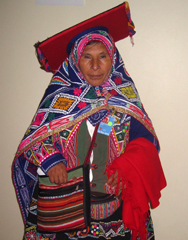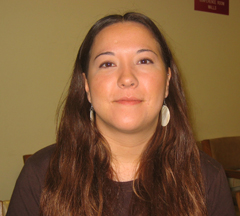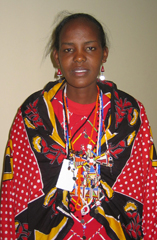World's Native Peoples Take on Climate Change
Air Date: Week of May 9, 2008

Hilaria Supa is a Peruvian congresswoman and an activist for human rights and protection of the environment. (Photo: Bobby Bascomb)
Despite their geographic differences, indigenous people often have similar problems when it comes to the environment. Living on Earth’s Bobby Bascomb reports.
Transcript
GELLERMAN: Indigenous peoples, who often live at the bottom of the economic ladder, are also those most at risk from climate change. Now they’re making their voices heard at the United Nations. Living on Earth’s Bobby Bascomb went to the UN’s Permanent Forum on Indigenous Issues and has our report.
BASCOMB: There are seven coal-fired power plants within 100 miles of the Three Tribes reservation in New Town, North Dakota. Kandi Mossett grew up on the reservation. She blames the energy industry for the strange sores and tumors subsistence hunters notice when they cut open fish and game.
MOSSETT: The Elders say what happens to the animals will happen to us.
BASCOMB: What’s happening to Mossett’s tribe is cancer. Studies show that cancer rates among Native Americans are 13 percent higher than in whites.
MOSSETT: I myself had cancer at the age of 20. My grandfather has already survived prostate cancer. And it’s not necessarily even the older folks. It’s the children. We’re seeing leukemias. We’re seeing all these babies that are dying. Six months old and they have cancers.

Kandi Mossett is an organizer for the Indigenous Environmental Network. She is a member of the Mandan, Hidatsa and Arikara Nations whose reservation is located near New Town, North Dakota.
MOSSETT: We all have these same stories of displacement, of unfair treatment by the corporations and industries – that it feels like the corporations and the governments consider them expendable.
[SUPA SPEAKING SPANISH]
BASCOMB: Hilaria Supa is a member of Peru’s congress. Her skirt and shawl are embroidered with the brightly colored patterns of her Quechua people. Gold and copper were discovered on native lands in Peru, and Supa worries about how they are mined.
[SUPA SPEAKING SPANISH]
TRANSLATION VOICEOVER: They use a mining technique called open pit mining. The chemicals used mainly uranium, sometimes mercury. They run off from the mountains where they’re mining down hill and get into the community rivers to the lakes to the underground water.
[SUPA SPEAKING SPANISH]
BASCOMB: Supa says studies have found that indigenous children who live near these mines have seven to ten times the acceptable level of lead in their blood.
MALEZER: Well, the impact is definitely greater upon the indigenous peoples.
BASCOMB: Lez Malezer is an Aboriginal Australian from the Gubby Gubby Batchula language group near Fraiser Island. His big concern is climate change. The long drought in Australia has forced native people off their land and into cities. His people won’t be able to care for the land as their ancestors did.
MALEZER: We believe that we have to be interacting with the environment in order for the environment to be healthy and strong and similarly in order for us to be healthy and strong.
BASCOMB: Malazer says aboriginal people like him are in a unique position to help defend the environment from the effects of climate change.
MALEZER: A big part of it is in fact for governments to recognize the knowledge, the expertise, the skills that indigenous peoples have in terms of being able to read the climate and understand the situation of the flora and fauna and how they’re best managed.

Grace Salam a member of the Maasai tribe in Kenya. She works with NGOs to dig wells, install solar panels and introduce new farming techniques to her community.
SALAM: I think it is maybe because of the climate change. We used to know the time of our drought and the time that there’s not drought. But now we can’t predict. We don’t know what comes next. So, the drought can be the whole year and all the cows died. And we’ll be having a very hard time of famine.
BASCOMB: The Maasai depend heavily on their cows. Milk makes up the bulk of their diet.
SALAM: So when the cows die that’s almost the end of the Maasai community life.
BASCOMB: Salam says it’s not just cows that are dying, but medicinal plants as well. She’s worked with NGOs and women’s groups in her community to adapt to climate change.
SALAM: We are trying to drill wells for people to use when there is a drought. We are trying to teach people ways that they will adapt in the situation. Like introducing solar panels. When there’s drought there’s so much of sun. We have already put up the solar panels in 150 households. We’re also teaching them how to plant some crops rather than just keeping animals.
BASCOMB: When they put up solar panels and plant crops, the Maasai are also rooting themselves to one piece of land. They’ve been nomadic pastoralists for millennia so the change to their culture is profound.
But like many indigenous people the Maasai understand that they need to sacrifice some of their culture to survive in the changing world.
For Living on Earth, I’m Bobby Bascomb.
Links
United Nations Permanent Forum on Indigenous Issues
Indigenous Environmental Network
The Maasai Cultural Exchange Project
Living on Earth wants to hear from you!
Living on Earth
62 Calef Highway, Suite 212
Lee, NH 03861
Telephone: 617-287-4121
E-mail: comments@loe.org
Newsletter [Click here]
Donate to Living on Earth!
Living on Earth is an independent media program and relies entirely on contributions from listeners and institutions supporting public service. Please donate now to preserve an independent environmental voice.
NewsletterLiving on Earth offers a weekly delivery of the show's rundown to your mailbox. Sign up for our newsletter today!
 Sailors For The Sea: Be the change you want to sea.
Sailors For The Sea: Be the change you want to sea.
 The Grantham Foundation for the Protection of the Environment: Committed to protecting and improving the health of the global environment.
The Grantham Foundation for the Protection of the Environment: Committed to protecting and improving the health of the global environment.
 Contribute to Living on Earth and receive, as our gift to you, an archival print of one of Mark Seth Lender's extraordinary wildlife photographs. Follow the link to see Mark's current collection of photographs.
Contribute to Living on Earth and receive, as our gift to you, an archival print of one of Mark Seth Lender's extraordinary wildlife photographs. Follow the link to see Mark's current collection of photographs.
 Buy a signed copy of Mark Seth Lender's book Smeagull the Seagull & support Living on Earth
Buy a signed copy of Mark Seth Lender's book Smeagull the Seagull & support Living on Earth

